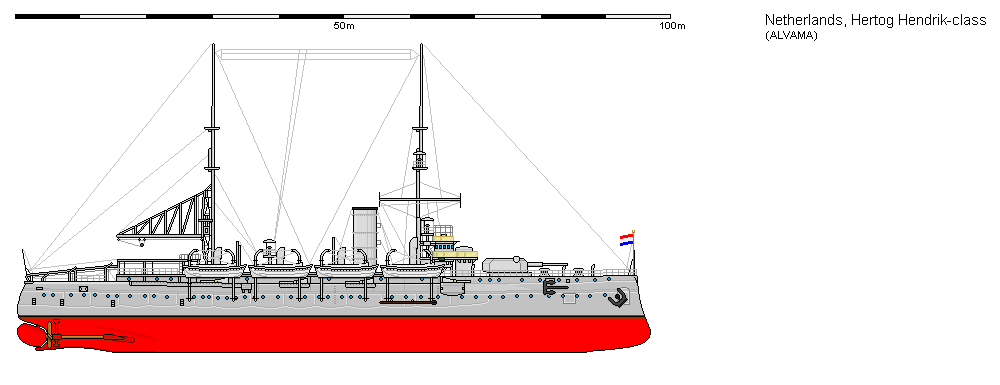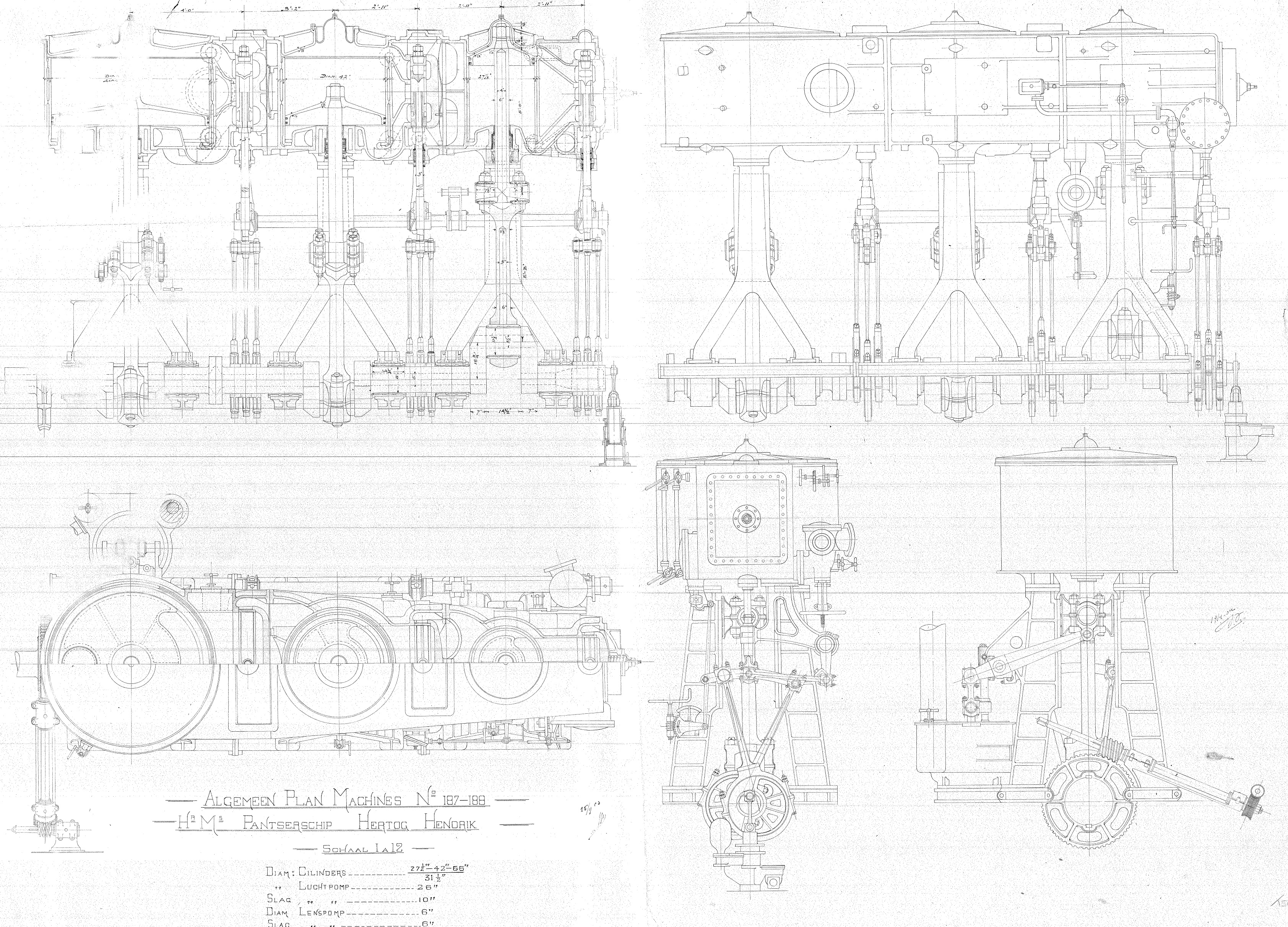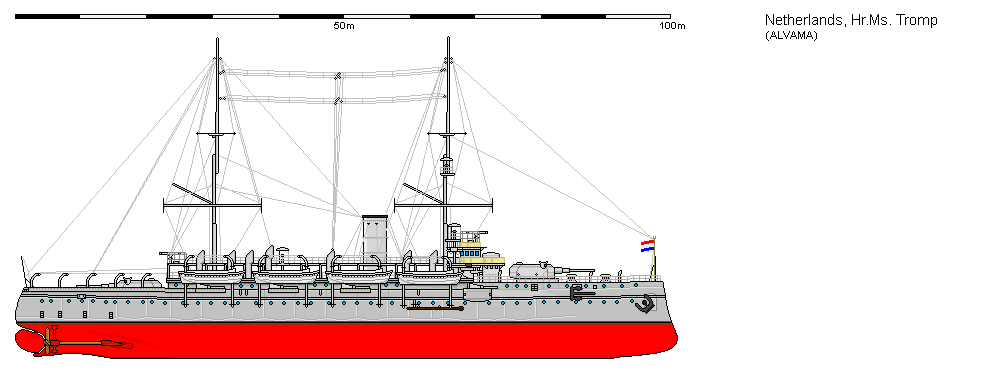Hertog Hendrik. Drawing by Alexander Mariy van Maanen
CC-BY-SA Gemeentearchief Vlissingen-Archief Machinefabriek/Ketelmakerij De Schelde Kon.Mij. De Schelde 1876-1938 inv.nr.306.
CC-BY-SA Gemeentearchief Vlissingen-Archief Machinefabriek/Ketelmakerij De Schelde Kon.Mij. De Schelde 1876-1938 inv.nr.306.
M.H. Tromp Drawing by Alexander Mariy van Maanen
An item reported that the intention was to decrease the Dutch squadron in the Dutch East Indies with one coast defence ship. The result was however that the squadron would be separated and the squadron command disbanded. Strangely enough would the coast defence ship -yet unknown if this was the Hr.Ms. Hertog Hendrik (1) or Tromp (2) would stay in the Dutch East Indies as a reserve for the ship in service.
Notes
1. On stocks at the navy yard at Amsterdam 13 October 1900 and launched 7 June 1902 by the Dutch prince Hendrik (after which she was named) which was married with queen Wilhelmina. Trials found place 9 September 1903 and she was commissioned 5 January 1904. Building costs were 4.300.000 Dutch guilders, in euro’s 1.951.255,-. Displacement 4.950 tons and dimensions 96,60 x 15,20 x 5,70m. Her 2 vertical triple compound engines delivered 6.282 hp allowing a speed of 16,5 miles. Armour consisted of a 150-100mm belt, 250mm gun turrets, 50mm deck and 250mm conning tower. Originally armed with 2-24cm guns, 4-15cm guns, 8-7.5cm guns, 4-3.7cm guns, 1 torpedo tube and 2 torpedo guns. In 1926 were the aft 24cm gun and the torpedo armament removed. In 1937 were 4-40mm machineguns placed and 2-7.5cm guns removed. After the rebuilding in 1926 was she commissioned 2 May 1927 but in the summer a year later was she fitted out with a crane for two-four floating planes. After 1935 the crane was removed. In the Spanish Civil War used for escort duties. In 1938 she was decommissioned but at the outbreak of the Second World War again in service as the battery ship Vliereede serving off Texel. Decommissioned 11 November 1939 and laid up at the navy yard at Den Helder. She was sunk by own personnel May 1940, salvaged by the Germans and rebuild at Antwerp as the floating battery Ariadne. In May 1945 found back at Wilhelmshafen and rebuilt at the Wilton-Fijenoord yard as an accommodations hip. Commissioned 21 October 1947 at Amsterdam as Wachtschip Amsterdam and later at Willemsoord still called Hertog Hendrik (A 888). Decommissioned 27 September 1968 and sold 28 August 1972 to be broken up.
2. Coast defence ship Marten Harpertsz Tromp, often referred to as just Tromp. She was laid down at the navy yard at Amsterdam, Netherlands 2 May 1903, launched 15 June 1904, trial 17 November 1905 and commissioned 5 April 1906. The two triple expansion engines and boilers were built at the yard Koninklijke Maatschappij De Schelde at Flushing, Netherlands. They provided 6.405 ihp driving two screws allowing a speed of 16,66 miles. Her crew numbered 345 men. The armament consisted of 2-24cm guns, 4-15cm guns, 8-7.5cm guns, 4-3.7cm guns, one submerged torpedo tube and two submerged torpedo guns. The armour consisted of a 100-150mm belt, 200mm gun turrets, 50mm deck and a 200mm conning tower. Costs for first fitting out for sea duty were ƒ 4.700.000,00. According to the annual budget account for 1910 was she repaired in the period 5 March-17 October and laid up still being in service. Total costs for that year amounted ƒ 365.919,37 for the hull and ƒ 138.773,63½ for (consumption) articles. According to Vermeulen was she decommissioned in the period 5 March-18 October. She was commissioned 18 October 1910 and departed towards the Dutch East Indies. She departed 4 August 1916 Surabaya towards the Netherlands via Japan, San Francisco and New York. She arrived 2 December at the Nieuwediep (Den Helder). Just after her arrival at the Nieuwediep was she visited by the Dutch queen Wilhelmina. After some voyages for instance again towards the Dutch East Indies was she decommissioned 2 May 1927, stricken 1932 and leaving 6 December 1933 Den Helder towards Pernis to be broken up. Part of her armour was used to strengthen in 1933 the fortress Kijk Uit at Den Helder.



